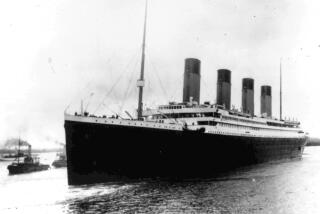Our Litigious Society, Circa 1912
- Share via
Raise your hands: How many of you left the theater after seeing “Titanic” saying something like this: “Wow. Suppose that had happened today. Can you imagine all the lawsuits?”
By the time we reached our car, my friends and I were planning the class action and counting the punitive damages. “I guess if they’d had our legal system then,” said one, “it would have been the end of transatlantic travel.”
OK, so I hang out with too many lawyers. You were involved with the romance of Rose and Jack and didn’t stop to think about the supposed “litigation explosion” of our own era.
But guess what? The historical record shows that everything new was old again. Both the survivors and the families of the victims evidently thought lawsuit almost as soon as they dried off or heard the news.
For American litigants, a lot rode on the question of which nation’s law was governing. If British law applied (because the ship was flying the British flag), then the Oceanic Steam Navigation Co., the Titanic’s owner, would be liable for up to $2 million. If American law governed, (under an 1800s law passed to protect American shipowners) the total maximum damage award would be a mere $96,000. In 1914, two years after the disaster, the U.S. Supreme Court ruled in favor of American law and the shipping company.
Within a year of the disaster, survivors and victims’ relatives had filed $13 million in claims, a figure that meant a lot more then. Neither rich nor poor were too shy to come forward, nor did gratitude for their miraculous survival preclude survivors from seeking recompense for every penny in property loss. Mabelle Moore sought half a million dollars for the loss of her husband and an additional $10,000 for the property he had on board. Mary Holverson wanted only $100,000 for the loss of her husband and $974 for his baggage, but tacked on another $920 to erect a monument in his honor. Clara Frauenthal sought more than $20,000 for her diamond, sapphire and pearl jewelry. Then there was Mary McGovern, who initially wanted only $50 for two sunken Irish crochet collars. But after attending court hearings on the suit, she upped her claim to $70 to cover her time. As far as I can tell, Rose never tried to collect on behalf of Jack.
The litigation had all the ingredients of a contemporary megasuit. The shipowners argued that they should not be held to blame for an unforeseeable accident. The night was hazy, so the lookouts could not have made use of their spyglasses, even if that equipment hadn’t mysteriously disappeared between Belfast and Southampton. Sailing across the ocean with only enough lifeboats for half the passengers complied with the letter of the English law. Even if the owners were held negligent, they shouldn’t be forced to pay, because the passengers’ tickets included language that limited their liability.
The plaintiff attorneys first tried to break the caps on damages, then squabbled for months over their fees.
In the key trial, held in England, lawyers argued back and forth about the weather, the receipt of warning telegrams (hard to prove, since most of the operators went down with the ship) and whether Titanic was proceeding at an unsafe speed. Each side had its own experts with clashing opinions about the nature of icebergs and the effects of haze and calm waters on their visibility. The jury deliberated briefly and found for the plaintiff victims on some grounds and against them on others. The shipping firm appealed, claiming that the jury didn’t know what it was doing.
So perhaps our own age is not peculiarly litigious. But I do know the title for the movie sequel: “Titanic II, the Litigation.”
More to Read
Sign up for The Wild
We’ll help you find the best places to hike, bike and run, as well as the perfect silent spots for meditation and yoga.
You may occasionally receive promotional content from the Los Angeles Times.






